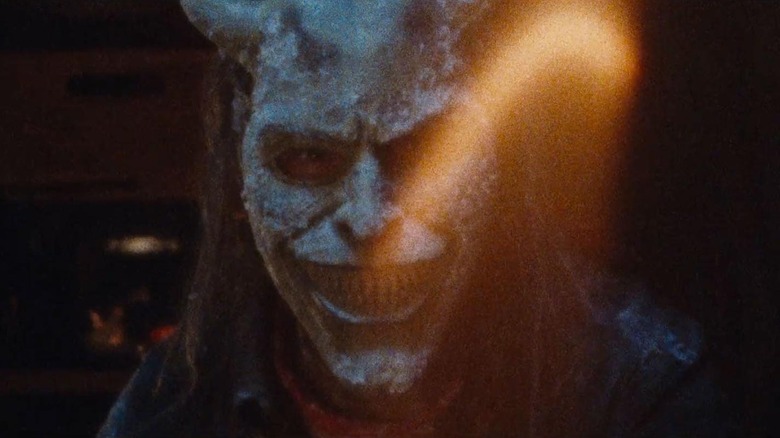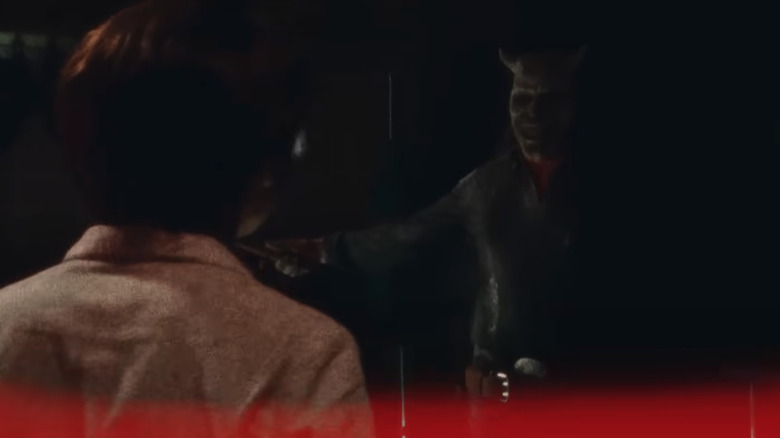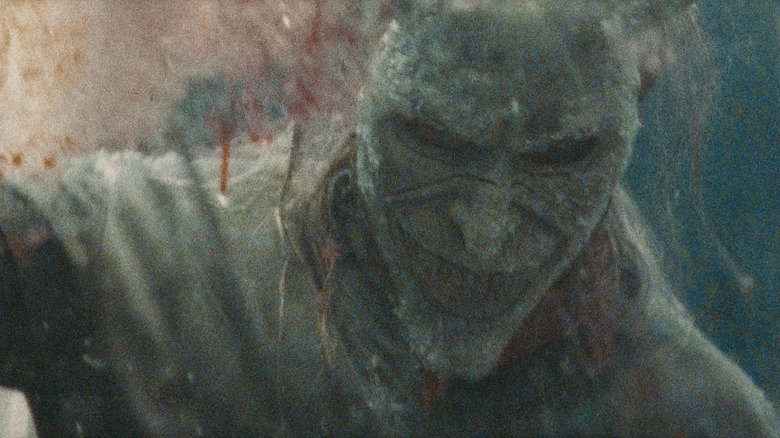Here's Why Black Phone 2's Horrifying Nightmare Scenes Will Delight Serious Film Nerds
When the trailers for "Black Phone 2" first dropped, it became immediately clear that Scott Derrickson and C. Robert Cargill were escalating their return to familiar territory. The sequel plunges deeper into The Grabber's gnarled lore, exposing past transgressions, unsolved murders, and the supernatural to expand their world into something so much larger than what came before. Narratively, the film also raises the stakes by showing The Grabber as an entity that can continue to intimidate the Blake siblings, Finney and Gwen, from beyond the grave. To further emphasize this metamorphosis, "Black Phone 2" utilizes the uncanny brightness of snow-covered landscapes at night to wash the world in deep blues and muted tones, imbuing the cold, haunted environment with a sense of desolate beauty.
But it's when the film shifts between the slick cinematic polish of Camp Alpine Lake to the raw, handheld grittiness of Super 8 film to showcase the dream realm where The Grabber terrorizes Gwen that the film twists into a waking nightmare. There's something deeply unsettling about the way the film melts between contemporary clarity and vintage deterioration, with the Super 8 sequences bleeding into the narrative like leftovers of corrupted memory. Pär M. Ekberg's cinematography feels like the film is being infected right before our eyes, evoking a similar sensation to that of Derrickson and Cargill's home movies in "Sinister."
There's something perversely beautiful about how Derrickson and his team render trauma as texture — the freezing cold of the real world is drained of color, while the fevered hauntings of the dream realm pulse with life. The Hell that comes to Earth in "Black Phone 2" feels palpable because the texture of the Super 8 elicits a visceral reaction ... and it was all done practically.
Black Phone 2 embraces the horror of Super 8
Not unlike DC Studios leader James Gunn, screenwriter C. Robert Cargill is pretty accessible on social media for someone who pens major motion pictures. Fans have been taking to Bluesky to ask Cargill for behind-the-scenes information about "Black Phone 2," including one who asked about how they pulled off the Super 8 sequences for the film. "No digital trickery in this. All the sequences that look like film, are," Cargill posted. As it turns out, they used Super 8 proper for the scenes without sound, and Super 16 for the moments that featured dialogue, which were then cut in half to be 8mm. Meaning, the moments shot on Super 16mm were framed with half the image and then expanded for even more of that grainy look — old-school, practical, classic filmmaking.
/Film also attended the Q&A after the film's premiere at Fantastic Fest, where Derrickson elaborated on this, saying, "Everything you see up there is real film. There's nothing up there that's digital photography made to look like film." Derrickson explained that the team was "very dedicated" to making sure the scenes shot on film were the best they could possibly be. "I just feel like it's beautiful — it's not just a love for film, it's a love specifically for the recklessness of Super 8," said Derrickson. "You get aberrations. You get weird things that happen, weird flares." That weirdness only enhances the supernatural quality of "Black Phone 2," helping to engross the audience in the abject horror of what The Grabber has planned.
Super 8 helped shape one of Scott Derrickson's favorite scenes
While plenty of filmmakers have used digital effects to try and replicate the look of Super 8, there's always something a little artificial about it that pulls you out of the immersion. No matter how much technology advances, there is no replacement for the real thing. I spoke with Maggie Levin, second unit director of "Black Phone 2," who informed me that "the Super 16 wasn't always for sound, it was also to allow for more dynamic lensing." The team used identical stock for both types of cameras, and then framed up for a centered 8 mm extraction on the 16 mm.
Super 8 and Super 16 cameras are also pretty particular, and the crew was constantly rotating out cameras that were locking up due to the cold weather. "It was 6 degrees one night, so the camera was literally freezing and wouldn't get up to a consistent speed," Levin tells me. "Which looked all the more scary when we printed the film." But that wasn't going to stop the creative team from pursuing what they knew would be the best way to display the dreamscape.
"It feels dreamlike to me, and I've always felt that Super 8 feels transgressive," said Derrickson during the Q&A. "I've always said if you just found Super 8 films in your grandmother's closet and a projector and put them on, it'd make you feel weird, because there's something about the medium, so the idea of letting the language of the dream world be entirely captured by Super 8 was technically very challenging and very difficult to do, but it was really worth it, I think."
"Black Phone 2" is now playing in theaters everywhere.


